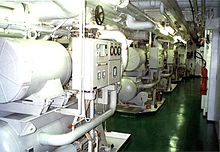Cargo cooling system
Refrigerated ships (definition: all holds are insulated and cooled) and refrigerated container ships for porthole containers are equipped with ship-mounted cargo refrigeration systems. The heart of every cargo cooling system are the refrigerant compressors of the refrigeration system .
A distinction is made between indirect and direct charge cooling systems.
Indirect cargo cooling systems
Indirect cargo cooling systems consist of the
- Refrigeration system for generating cold with the low-boiling refrigerant
- Brine system for cold transfer from the cooling system to the cargo hold
- Air system to dissipate heat from the hold
- Cooling water system for heat dissipation in the condenser in the cooling system.
Direct cargo cooling systems
With direct cargo cooling systems, the evaporators are installed in the hold or in the cooling rod (porthole container) and the brine system is not required. You will either
- usually in the engine room or centrally
- decentrally installed in the deckhouses / side corridors near the air cooler.
Executions
Example refrigerated ship
The modern, medium-sized refrigerated ships have four hatches and four decks, resulting in a total of 16 refrigerated holds that can be divided into 8 to 16 temperature zones. Each temperature zone is equipped with two or more refrigerant evaporators (direct system) or air coolers (indirect system) and can run a different cargo space temperature depending on the load. The heat is dissipated from the cargo holds with the help of fans via the refrigerant evaporator (or air cooler).
Example reefer container ship with porthole containers
On a refrigerated container ship, the refrigerated cargo is in insulated containers that are connected to a ship-mounted air cooling system on the ship, as shown in the schematic diagram. It shows the refrigeration system for generating cold, the brine system for transferring cold from the refrigeration system to the cooling rods in the cargo hold and the air system for removing heat from the porthole container in the cargo hold. The cooling water system for heat dissipation in the condenser of the cooling system is indicated. The insulated cooling rods consist of two vertical air ducts, a fan, an air cooler, a temperature control and two horizontally movable couplings per cooling container for connecting the cooling containers.
literature
- Hochhaus, K.-H .: Technical developments of refrigerated container ships, Schiff & Hafen No. 10/1993
- Hochhaus, K.-H .: Deutsche Kühlschiffahrt, Hausschild Verlag, Bremen, 1996
- Hochhaus, K.-H., Glandien, H .: Cool - Reefer technology with a future, Seehafen Verlag, Hamburg 2007 ISBN 978-3-87743-818-3


